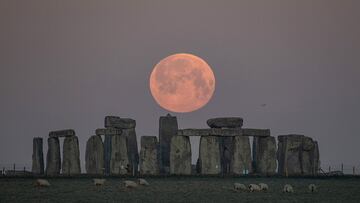How to see the August 2023 Super Blue Moon
On Wednesday, the Moon will be putting on a show for all to see, weather permitting, in a phenomenon that won’t occur the same again until 2115.

Those of you who enjoy going out as the Sun goes down to do some stargazing won’t want to miss the chance that will present itself on Wednesday evening. Weather permitting you will be able to catch the rare sight of a Super Blue Moon, the first since 2018.
While supermoons occur in series every year, and blue moons roughly every two and a half years, both happening at the same time is truly special occurring on average every ten years. Keep in mind though that the next one won’t happen until 2037, and one like this until 2115.
How to see the August 2023 Super Blue Moon
First off, you’ll want to find a good spot with an unobstructed view of the horizon for the most spectacular views, and pray that it’s not cloudy. You can check the time of the moonrise where you live using the handy moonrise and moonset calculator for locations in the United States available at the Old Farmer’s Almanac.
Catching sight of the event as it comes into view will make it seem even bigger than it really is thanks to the ‘big moon illusion’. To know exactly where it will appear on the horizon there is an online application MoonCalc, which will come in useful if you want to take a picture.
Stargazers are in for a treat on Wednesday evening: a rare super blue moon! 🌕
— US Department of the Interior (@Interior) August 29, 2023
The closest, brightest full moon of the year is also the second full moon in August. Where will you be watching?
Photo at @JoshuaTreeNPS by Brad Sutton pic.twitter.com/jmAT8FZS0i
How to take a picture of the Super Blue Moon?
If you are looking to catch the perfect photo of the supermoon there are some tools that can help you. For your smartphone there is a useful app, PhotoPills, available for iOS and Android. So that you can make the most of using the app PetaPixel gives a walk through of the app’s features.
What is a supermoon?
Supermoons occur when the moon is full at the same time as its closest approach to Earth in its elliptical orbit, or perigee. A full moon is considered a supermoon, not an official astronomical term, when it comes within 90 percent of perigee. They always appear consecutively happening three or four times a year.
According to NASA: “Different publications use slightly different thresholds for deciding when a full moon is close enough to the Earth to qualify as a supermoon.” Because the orbit of the moon is not a perfect circle, the moon is sometimes closer to the Earth than at other times during its orbit.
On average, supermoons appear about 7 percent bigger and about 15 percent brighter than a typical full moon. Compared to the moon at its faintest, a supermoon is roughly 14 percent bigger and 30 percent brighter.
What is a blue moon?
A blue moon is when a second full moon occurs in the same calendar month. This happens roughly every two and a half years. According to NASA, 25 percent of full moons are supermoons while only 3 percent of full moons are blue moons, thus the expression “once in a blue moon” to indicate that something rarely happens.
What’s better than a #BlueMoon? A Super Blue Moon! 🌕💙
— The Weather Network (@weathernetwork) August 23, 2023
While Perigee Full Moons occur annually, Perigee Blue Moons are surprisingly rare! The next one won’t occur until December 2115. So, remember to look up on the night of Wednesday, August 30! pic.twitter.com/HL5j4Skfk0
How far will the moon be from the earth during the blue moon?
What makes this Super Blue Moon special is that it will occur when the Moon is just about at perigee, 221,942 miles, or 357,181 km, away on Wednesday. That will occur at 12 pm ET according to Space.com. The full, full moon won’t happen for another 9 hours and 36 minutes, but honestly most observers, much less the naked eye, won’t be much the wiser.
Related stories
What makes the August 2023 Super Blue Moon a little more special than the one that will occur in 2037 is the proximity of the Moon when the event happens. Such proximity combined with a second full moon in the same month won’t happen again until 2115.
Enjoy the view!


